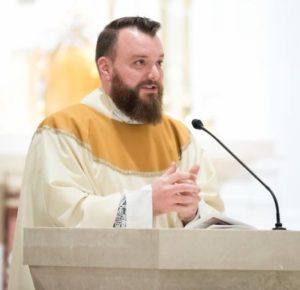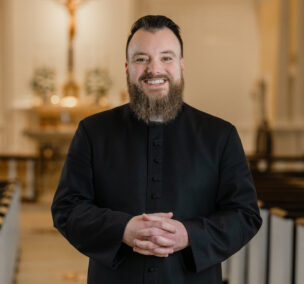 Dear Brothers and Sisters in Christ,
Dear Brothers and Sisters in Christ,
As I wrote last week, Lent is a season that reorients us spiritually, toward the Lord. Accepting ashes on our heads, we received the command “Repent, and believe in the Gospel.” The disciplines of prayer, fasting, and almsgiving, in whatever form we have chosen to observe them this year, help us learn how to turn to God more completely. I wrote also about the “eastern” direction of prayer, that is, that Christian prayer is ad orientem – to the east – and how this orientation in both a physical and symbolic way serves to remind those who pray that they are to turn to Lord with their whole being, body and soul. Being oriented to the east is a symbolic way of looking to the rising sun that is Jesus Christ and allowing His light to shine in our lives so that we can see our truest identity, and in that light recognize the ways we still must grow as well as the ways we are being sent to bring His light into the world.
The discipline of prayer to which we are called in Lent is, of course, a practice intended for our entire lives. In these forty days, the Church urges us to a more profound experience of prayer. If we are to truly repent and believe in the Gospel, to make that turn away from sin and to the love of God, an interior transformation must take place. Prayer is the vehicle for that inner turn, that personal and invisible reorientation. St. Teresa of Avila wrote that “Prayer is when we raise our hearts and minds to God.” She continues the thought saying, “Prayer is to realize how much it means to you to have God’s friendship and how much he loves you.” Following in the footsteps of her Carmelite foundress, St. Therese of Lisieux would say “For me, prayer is a surge of the heart; it is a simple look, turned toward heaven, it is a cry of recognition and of love, embracing both trial and joy.” On Ash Wednesday we were challenged to reorient our lives to God. Prayer is the path to this repentance, the way in which we turn to God.
Christian prayer carries with it certain physical elements. For example, we make the sign of the Cross, a bodily incarnate reminder that we are beginning or ending a time of conversation with the Lord. In the Catholic tradition, kneeling in prayer is a sign of humility before the Lord and a posture that helps us to focus our attention. It becomes an outward sign of the inner reality. We often pray in the presence of the Blessed Sacrament, facing the Tabernacle and aware of the Real Presence of Jesus as we open our minds and hearts to God. Whether in Church or at home, many Catholics pray while looking at images of the Holy Family or the saints. Prayer can be aided by sacred music, which allows us to hear some small reflection of the eternal choirs praising God in heaven. Our voices raised in prayer give outward expression to the interior, silent prayer being offered in the heart. In all these practices and countless others, our bodies help us to reorient our lives and turn more perfectly to God.
The practice of prayer turns us to the light of Christ, that rising sun that shows us who we really are. If, as St. Therese says, prayer is a simple look turned toward heaven, it is safe to say that when we pray, our turn toward heaven is met by the steady, infinite gaze of our loving God. To be ad orientem, turned to the east, is to turn spiritually to the light. So in prayer, we accept and receive the light of Christ. This light enables us to see who we really are; in baptism we were brought into His life, made sons and daughters of our Father. In the light of prayer, we recognize our profound dignity and worth. Prayer is both the way for us to speak to the Lord and a time for God’s voice to be heard. In the light of prayer, God speaks to our hearts. We should be prepared for the fact that, while this converse with the Lord reminds us of our true identity, prayer does not mean a divine affirmation of everything about our lives. On the contrary, it is in prayer that the Lord can reveal to us our weaknesses, our sin, and the ways in which He wants to bring us to conversion and healing. Interiorly turned to the Lord, aided by our body’s prayerful posture, the light of Christ teaches us those ways of thinking, speaking, and behaving that need His light. The ugliness of our sin and our personal flaws becomes evident, but in the context of this loving conversation with God our awareness of personal sin drives us to deeper repentance rather than despair. The light from the east, from Christ, becomes the great attraction. And so we begin, as the fruit of prayer, to turn our backs on our sinful past, on our sinful habits, on our sinful thoughts. Bathed in the light that comes from Christ, our minds, our tongues, our hearts, our very bodies are reoriented to the Lord.
The Lenten discipline of prayer ought to become a life-long discipline. In order for prayer to truly turn us ad orientem, we need to create the interior and exterior environment conducive to this reordering. To pray well, we should situate ourselves physically in such a way that our posture and the silence around us allows us to give our attention in a meaningful way to the task at hand. Whenever possible, we should take advantage of the opportunity to pray in the presence of the Blessed Sacrament: to that end, the Chapel here at St. Pius remains open 24 hours a day. When we cannot pray with the Eucharist, we should practice prayer in a conducive location. A few years ago, I found myself praying at sunrise in the wilderness in Montana. Though I tried to orient myself physically to the east so I could see the sun rise, because I was in a valley the mountains blocked the sun. But as the light began to creep over those mountains, the colors of the valley came to life before me, a visual reminder of the ways that God wants to show us so much more than we can imagine if only we will turn to His light. When we pray, Jesus is inviting us to turn to Him, to listen attentively, to pour out our hearts, to be enlightened and to be converted. In prayer, as we orient ourselves to the Lord, we find that God is the one who truly directs and turns us, so that those powerful words can echo in our hearts, minds, and lives: “Repent, and believe in the Gospel.”
Peace,

Fr. Sam


